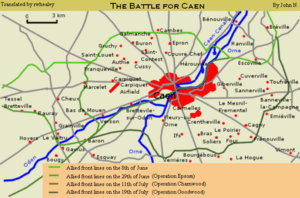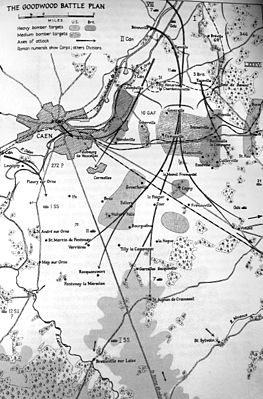Operation Atlantic facts for kids
Quick facts for kids Operation Atlantic |
|||||||
|---|---|---|---|---|---|---|---|
| Part of the Battle for Caen | |||||||
 |
|||||||
|
|||||||
| Belligerents | |||||||
| Commanders and leaders | |||||||
| Strength | |||||||
| 2 Infantry divisions 1 Armoured Brigade |
2 Panzer divisions | ||||||
| Casualties and losses | |||||||
| 1,349–1,965 | Unknown | ||||||
Operation Atlantic was a major military attack by Canadian forces during the Second World War. It took place from July 18 to 21, 1944, as part of the larger Battle of Normandy. The main goal of this operation was to capture the French city of Caen and the surrounding areas from German forces.
This attack was planned together with a British operation called Operation Goodwood. While Operation Atlantic had some early successes, especially near the Orne River, a key attack by Canadian soldiers on a strong German position called Verrières Ridge was very difficult and resulted in many casualties.
Contents
Background to the Battle
Why the Allies Attacked Caen
The city of Caen was a very important target for the Allied forces during the D-Day invasion on June 6, 1944. British commanders saw capturing Caen as a top priority. They wanted to control the city and the land around it. This would help them build airfields and protect the side of the American army as it moved towards Cherbourg.
Controlling Caen would also give the Allies a good starting point to attack southwards. Their plan was to capture Falaise and then move towards Argentan. The land between Caen and Vimont was open and dry, which was perfect for fast tank movements. Since the Allies had many more tanks than the Germans, a battle with lots of movement would be to their advantage.
Early Attempts to Capture Caen
On D-Day, the British forces could not capture Caen right away. German resistance was too strong. Later, the Allies tried a "pincer attack" called Operation Perch on June 7. This meant attacking Caen from two sides, like a crab's pincers. However, German forces, including the powerful 21st Panzer Division, stopped these attacks.
Another attempt to break through German lines happened during the Battle of Villers-Bocage. British tanks tried to capture the town of Villers-Bocage. Even though the British had to pull back, the Germans were eventually forced to retreat from some areas. Bad weather then caused delays for the Allies, as a big storm hit the English Channel for three days.
Pushing Towards Caen
On June 26, the British launched Operation Epsom. This attack aimed to go around Caen's defenses by crossing the River Odon to the west. The Germans managed to stop this attack, but they had to use all their tanks, including two new divisions. This stopped the Germans from launching their own planned attack against the Allies.
A few days later, the Allies tried again to capture Caen with Operation Charnwood. This attack included a separate plan called Operation Windsor to capture Carpiquet. On July 8 and 9, the northern part of Caen was captured. However, German forces still held the southern part of the city, across the Orne River. They also held the Colombelles steel works, which was a great spot for their artillery to watch Allied movements.
Planning the Attack
The Allied Strategy
On July 10, General Bernard Montgomery, who was in charge of all Allied ground forces in Normandy, met with his commanders. They discussed the next big attacks. Montgomery approved Operation Cobra, a major breakout attempt by the American army, set for July 18. He also told the British commander, Miles Dempsey, to "keep hitting" the Germans. This was to draw German strength, especially their tanks, onto the British and Canadian forces. This would make it easier for the American attack.
The detailed planning for Operation Goodwood began on July 14. On July 15, Montgomery changed the orders for Goodwood. It was no longer a "deep breakout" but a "limited attack." The new goal was to fight the German tanks and weaken them. This would also improve the British army's position. The orders stressed that the Canadian goals were now very important.
The Canadian Plan: Operation Atlantic
Lieutenant-General Guy Simonds was in charge of the II Canadian Corps. He would lead Operation Atlantic. His mission was to capture Colombelles and the part of Caen south of the Orne River. After taking these areas, the Canadians were to be ready to capture Verrières Ridge. Operation Atlantic and Goodwood were set to begin on July 18.
General Simonds planned Operation Atlantic as a two-part attack. The 2nd and 3rd Canadian Infantry Divisions would capture Vaucelles, Colombelles, and the areas across the Orne River. On the morning of July 18, General Rod Keller's 3rd Division would cross the Orne near Colombelles. Then they would move south towards Route Nationale 158 and capture Cormelles.
General Charles Foulkes' 2nd Division would attack from Caen to the south-east. They would cross the Orne to capture the edges of Vaucelles. After that, they would use Cormelles as a starting point to attack the high ground near Verrières Ridge, about three miles to the south.
The Battle Unfolds
On the morning of July 18, with strong air support, parts of the 3rd Canadian Infantry Division successfully captured Colombelles and Faubourg-de-Vaucelles. These were industrial areas just south of Caen along the Orne River. By the middle of the afternoon, two companies of the Black Watch had crossed the Orne River. They faced little resistance.
Other battalions from the 5th Brigade pushed further south to Saint-André-sur-Orne. With the east bank of the Orne River now secure, the 4th and 6th Canadian Infantry Brigades moved into position. They were ready for the difficult assault on Verrières Ridge.
The Fight for Verrières Ridge
The German High Command knew how important Verrières Ridge was. Even though it was only about 90 feet high, it controlled the main road from Caen to Falaise. This ridge blocked the Allies from breaking out into the open countryside south of Caen. The Germans had strong defenses there, including the 1st SS Panzer Corps with lots of artillery, nebelwerfer rocket launchers, and tanks.
In the early hours of July 20, units of the Queen's Own Cameron Highlanders of Canada managed to secure a position in St. André-sur-Orne. They were supporting the South Saskatchewan Regiment of the 2nd Division. However, they were soon pinned down by German infantry and tanks.
A direct attack up the slopes of Verrières Ridge by the South Saskatchewans failed. Heavy rain made the ground muddy, which made it hard for tanks to move. German counterattacks by two Panzer divisions pushed the South Saskatchewans back. They even crashed into their supporting battalion, the Essex Scottish. The Essex Scottish lost over 300 men trying to hold back the 1st SS Panzer Division. By the end of the day, the South Saskatchewan Regiment had 282 casualties, and the ridge was still in German hands.
General Simonds was still determined to take the ridge. He sent in two more battalions, the Black Watch and the Calgary Highlanders, to help. On July 21, their small counterattacks managed to stop the German armored forces. By the time the operation was called off, Canadian forces had secured some small positions on the ridge, including a key spot called Point 67. However, four German divisions still held most of the ridge. The fighting around Verrières Ridge during Operation Atlantic caused over 1,300 Allied casualties.
Aftermath
Casualties of Operation Atlantic
The Canadian Official Historian, C. P. Stacey, reported that Canadian forces suffered 1,965 casualties during Operation Atlantic. Out of these, 441 soldiers were killed or died from their wounds. Most of these casualties happened in the 4th and 6th Canadian Infantry Brigades.
Images for kids




